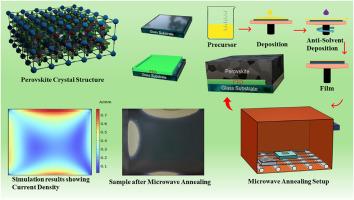Rapid microwave annealing of perovskite films: Exploring the mechanism of heat generation and influence on growth kinetics
IF 6.3
2区 材料科学
Q2 ENERGY & FUELS
引用次数: 0
Abstract
Perovskite solar cells have gained significant attention in both research and industry due to their simple manufacturing process, low cost, abundance of constituent materials, and high-power conversion efficiency. Thermal annealing is crucial for achieving optimal crystal growth in perovskite films. Recently, microwave processing has emerged as a rapid and energy-efficient alternative to conventional hotplate annealing. By using microwave annealing, we reduced processing time to one-tenth of the traditional methods while simultaneously enhancing crystal quality. However, the underlying heat generation mechanism remains unclear, requiring further investigation to optimise the process and enable widespread adoption of this scalable technology. This work explores microwave absorption and heat generation mechanisms in rapidly grown MAPbI3 perovskite films. Through simulations and experiments, we model the role of dielectric absorption and eddy current heating in perovskite/glass and perovskite/FTO layers, supported by structural, optical and electrical characterisation. Furthermore, we successfully mitigated the edge effect caused by electromagnetic wave diffraction, a common limitation of microwave annealing of semiconductors. We expanded classical nucleation theory with microwave-specific modifications, establishing a comprehensive framework that links microwave power to nucleation rates and grain growth. This work provides critical insights into optimising microwave processing parameters, advancing rapid thermal techniques for scalable, high-throughput perovskite solar cell manufacturing.

钙钛矿薄膜的快速微波退火:热生成机理及对生长动力学的影响
钙钛矿太阳能电池因其制造工艺简单、成本低、组成材料丰富、功率转换效率高等优点,在研究和工业领域都受到了极大的关注。热退火是实现钙钛矿薄膜最佳晶体生长的关键。最近,微波处理已成为传统热板退火的一种快速和节能的替代方法。通过微波退火,我们将加工时间缩短到传统方法的十分之一,同时提高了晶体质量。然而,潜在的产热机制尚不清楚,需要进一步研究以优化工艺并使这种可扩展技术得到广泛采用。本研究探讨了快速生长的MAPbI3钙钛矿薄膜的微波吸收和产热机制。通过模拟和实验,我们模拟了介电吸收和涡流加热在钙钛矿/玻璃和钙钛矿/FTO层中的作用,并提供了结构、光学和电学表征。此外,我们还成功地消除了微波退火半导体中常见的由电磁波衍射引起的边缘效应。我们扩展了经典的成核理论与微波特异性修改,建立了一个全面的框架,将微波功率与成核速率和晶粒生长联系起来。这项工作为优化微波处理参数、推进可扩展、高通量钙钛矿太阳能电池制造的快速热技术提供了重要见解。
本文章由计算机程序翻译,如有差异,请以英文原文为准。
求助全文
约1分钟内获得全文
求助全文
来源期刊

Solar Energy Materials and Solar Cells
工程技术-材料科学:综合
CiteScore
12.60
自引率
11.60%
发文量
513
审稿时长
47 days
期刊介绍:
Solar Energy Materials & Solar Cells is intended as a vehicle for the dissemination of research results on materials science and technology related to photovoltaic, photothermal and photoelectrochemical solar energy conversion. Materials science is taken in the broadest possible sense and encompasses physics, chemistry, optics, materials fabrication and analysis for all types of materials.
 求助内容:
求助内容: 应助结果提醒方式:
应助结果提醒方式:


